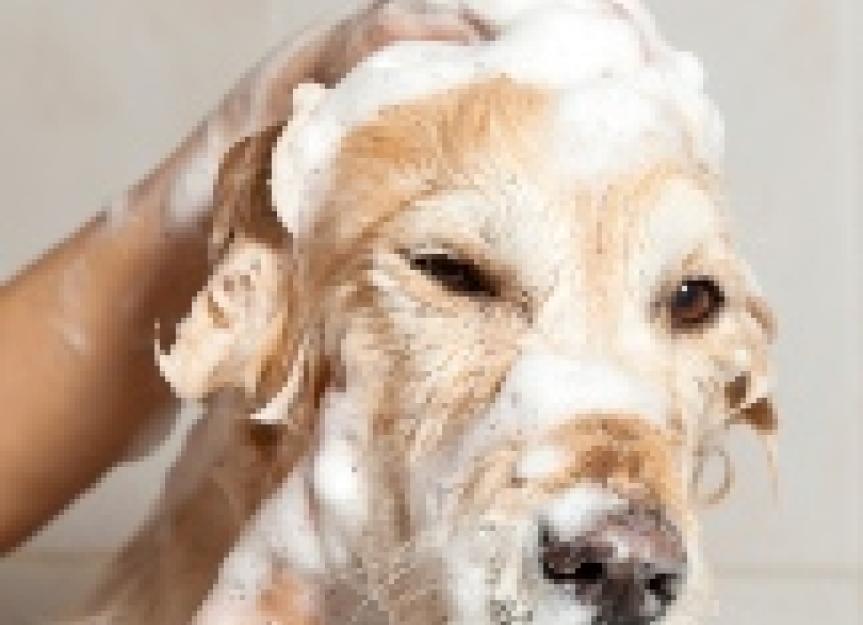Skunk Spray and How to Remove Skunk Smell from a Dog
Anyone who has ever had a pet sprayed by a skunk immediately can recognize that horrible, eye-watering stench. It invades and permeates not only the pet’s fur, but if you’re not astute and the pet runs into the house, it can add a lasting aroma to everything within your house.
Being sprayed by a skunk is not only a stinky annoyance, it can also lead to illness. Skunk spray has even been used as a biologic weapon — to disperse crowds and to cause injury.
For a skunk, it’s all about self-protection. Skunks are usually docile animals that are most active at dawn and dusk. They have good hearing and a good sense of smell but do not see well. If threatened by another animal, a skunk may first give a warning with a foot stamp, a hiss and a tail-raise. If the warning is not heeded — watch out — here comes the spray!
What is Skunk Spray?
Skunk “spray” is a secretion produced by the skunk’s anal glands. It can travel up to 15 feet and usually hits its mark. The fluid is a mixture of seven volatile compounds — consisting of thiols, thioacetates, and a methylquinoline. The thiols are the big contributors to the repellant odor, while the thioacetates help to make the smell last a long time — especially when water is added, which is why pets continue to smell even after a traditional bath.
What Effects Does Skunk Spray Have On Pets?
The effects can be oral, ocular (eyes), dermal (skin), and respiratory. The severity of the symptoms depends on what part of the body is sprayed and the proximity of the skunk. Symptoms can include:
- ocular swelling and redness
- squinting
- drooling
- sneezing
- vomiting
- temporary blindness
A more severe reaction can occur but is very rare. The thiol components can cause oxidative damage to red blood cells. The result is the destruction of red blood cells leading to anemia, but only a few cases have been reported in the literature and ASPCA toxicology database. One dog developed a mild to moderate case of anemia and recovered with supportive care. Another dog developed severe anemia, had a seizure and died. This is the only documented death related to a skunk spray in a dog.
The Japanese breeds of dogs (e.g., Akitas, Tosas, Shiba Inus) seem to be most susceptible to the effects of the spray. In general, cats are more sensitive to oxidative damage of their red blood cells when compared to dogs because of differences in their hemoglobin molecules (the oxygen-carrying molecules of the blood). It would seem likely that cats could develop anemia after being sprayed by skunks, but this has not been documented yet.
Treatment for Skunk Spray Toxicosis
Treatment is mostly supportive. The eyes and mouth should be flushed with warm water and the animal bathed to remove the chemicals from the skin. If the spray was heavy, baseline blood work should be assessed, with repeat blood work for 72 hours to monitor for anemia. Treatment for anemia may require intravenous fluids and blood transfusions.
How to Remove Skunk Smell from Dogs and Other Pets
The best formula tested (according to the TV show,Mythbusters) to de-skunk a dog, was chemist Paul Krebaum’s “baking soda and peroxide” formula.
The Skunk Remedy Recipe(from theSkunk Remedy Homepage)
在一个塑料水桶,以下是混合好ients:
- 1 quart of 3% Hydrogen Peroxide
- 1/4 cup of baking soda
- 1 to 2 teaspoons liquid soap (not detergent).
For large pets, add one quart of lukewarm tap water for complete coverage.
Wash pet promptly and thoroughly, work the solution deep into the fur. Let your nose guide you, leave the solution on about 5 minutes or until the odor is gone. Some heavily oiled areas may require a "rinse and repeat" washing.
Hints:
- Use the mixture promptly — effectiveness decreases with time.
- Do not store the solution — pressure will build up and the container can explode.
- 戴手套,避免宠物的眼睛——解决方法n can sting if it gets in the eyes or in cuts on the hands. Bleaching of fur, towels, etc. can occur due to the peroxide.
Don’t forget that skunks can carry rabies. If bite wounds are found, you should seek prompt veterinary treatment and guidance.

Dr. Jennifer Coates
References
- Means, Charlotte.Skunk Spray Toxicosis: An Odiferous Tale. DVM360.Electronic application. April 1, 2013.
- The Skunk Remedy Recipe. Accessed November 30, 2013.
Image: Thinkstock
Help us make PetMD better
Was this article helpful?
